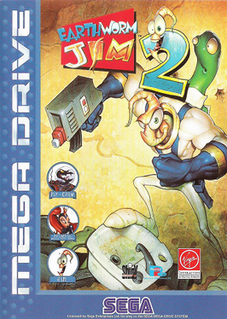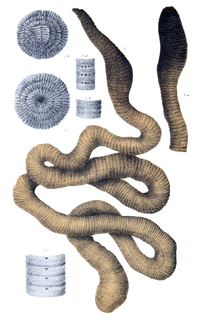
Douglas Richard TenNapel is an American animator, writer, cartoonist, video game designer, and comic book artist whose work has encompassed animated television, video games, and comic books. He is best known for creating Earthworm Jim, a character that spawned a video game series, animated series, and a toy line. He is also the creator of the animated television series Catscratch (2005–2007), which aired on Nickelodeon, and was itself a loose adaptation of TenNapel's comic book limited series Gear.

Earthworm Jim is a 1994 run and gun platform game developed by Shiny Entertainment, featuring an earthworm named Jim, who wears a robotic suit and battles the forces of evil. The game was released for the Sega Genesis, and subsequently ported to a number of other video game consoles.

Vermicompost (vermi-compost) is the product of the decomposition process using various species of worms, usually red wigglers, white worms, and other earthworms, to create a mixture of decomposing vegetable or food waste, bedding materials, and vermicast. This process is called vermicomposting, while the rearing of worms for this purpose is called vermiculture.

Lumbricus terrestris is a large, reddish worm species thought to be native to Western Europe, now widely distributed around the world. In some areas where it is an introduced species, some people consider it to be a significant pest for out-competing native worms.

The Lumbricidae are a family of earthworms. About 33 lumbricid species have become naturalized around the world, but the bulk of the species are in the Holarctic region: from Canada and the United States and throughout Eurasia to Japan. An enigmatic species in Tasmania is Eophila eti. Currently, 670 valid species and subspecies in about 42 genera are recognized. This family includes the majority of earthworm species well-known to Europeans.

Oligochaeta is a subclass of animals in the phylum Annelida, which is made up of many types of aquatic and terrestrial worms, including all of the various earthworms. Specifically, oligochaetes comprise the terrestrial megadrile earthworms, and freshwater or semiterrestrial microdrile forms, including the tubificids, pot worms and ice worms (Enchytraeidae), blackworms (Lumbriculidae) and several interstitial marine worms.

The Megascolecidae is a taxonomic family of earthworms which is can be found native in Australia, New Zealand and both South East Asia and North America. All of Megascolecidae species are belong to the Citellata class. Megascolecidae are a large family of earthworms and they can grow up to 2 meters in length. The intercontinental distribution of Megascolecidae helps in favouring the Continental Drift theory.

Earthworm Jim 2 is a run and gun platform video game and the sequel to Earthworm Jim, and the second and final game in the Earthworm Jim series developed by original creators Doug TenNapel, David Perry, and Shiny Entertainment. It was released in late 1995 and early 1996 depending on region and video game console, initially being released for the Sega Genesis and Super Nintendo Entertainment System, before being ported to other platforms.

The giant Gippsland earthworm, Megascolides australis, is one of Australia's 1,000 native earthworm species. It is also commonly known as karmai, taken from the Boonwurrung language.

Shiny Entertainment, Inc. was an American video game developer based in Laguna Beach, California. Founded in October 1993 by David Perry, Shiny was the creator of video games such as Earthworm Jim, MDK and Enter the Matrix. Perry sold the company to Interplay Productions in 1995, which sold the studio to Infogrames, Inc. in 2002. After Foundation 9 Entertainment acquired Shiny in 2006, the company was merged with The Collective in October 2007, creating Double Helix Games.

The coast mole or Pacific mole is a medium-sized North American mole found in forested and open areas with moist soils along the Pacific coast from southwestern British Columbia to northwestern California.

Earthworm Jim is an American animated television series based on the video game series of the same name and created by series creator, Doug TenNapel. The series aired on the Kids' WB for two seasons from September 9, 1995, to December 13, 1996. It follows the adventures of the titular character who battles the forces of evil using a robotic suit.
Metastrongylus is a genus of nematodes of the family Metastrongylidae, usually found as lungworms in pigs and sometimes causing parasitic bronchitis. It causes a disease called metastrongylosis.

The Tom Fun Orchestra is a Canadian indie rock ensemble from Cape Breton, Canada. The band features an unconventional mix of electric and acoustic instruments, including violin, banjo, accordion, trumpet, double bass, electric guitars and drums, and have elicited comparisons to acts ranging from The Clash, Tom Waits and The Pogues to The Arcade Fire and Broken Social Scene.
Earthworm Jim is a series of side-scrolling platform games featuring an earthworm named Jim who wears a robotic suit and battles the forces of evil. The series is noted for its platforming and shooting gameplay, surreal humor, and edgy art style. Four games were released in the series: Earthworm Jim, Earthworm Jim 2, Earthworm Jim 3D, and Earthworm Jim: Menace 2 the Galaxy, with the first game released in 1994. The series had laid dormant for almost a decade before Gameloft remade the original game in HD for PlayStation Network and Xbox Live Arcade in 2010. Interplay announced Earthworm Jim 4 in 2008, but little has surfaced since.

Worms are many different distantly related animals that typically have a long cylindrical tube-like body, no limbs, and no eyes. Worms vary in size from microscopic to over 1 metre (3.3 ft) in length for marine polychaete worms, 6.7 metres (22 ft) for the African giant earthworm, Microchaetus rappi, and 58 metres (190 ft) for the marine nemertean worm, Lineus longissimus. Various types of worm occupy a small variety of parasitic niches, living inside the bodies of other animals. Free-living worm species do not live on land, but instead, live in marine or freshwater environments, or underground by burrowing. In biology, "worm" refers to an obsolete taxon, vermes, used by Carolus Linnaeus and Jean-Baptiste Lamarck for all non-arthropod invertebrate animals, now seen to be paraphyletic. The name stems from the Old English word wyrm. Most animals called "worms" are invertebrates, but the term is also used for the amphibian caecilians and the slowworm Anguis, a legless burrowing lizard. Invertebrate animals commonly called "worms" include annelids, nematodes (roundworms), platyhelminthes (flatworms), marine nemertean worms, marine Chaetognatha, priapulid worms, and insect larvae such as grubs and maggots.

An earthworm is a terrestrial invertebrate that belongs to the phylum Annelida. They exhibit a tube-within-a-tube body plan, are externally segmented with corresponding internal segmentation, and usually have setae on all segments. They occur worldwide where soil, water, and temperature allow. Earthworms are commonly found in soil, eating a wide variety of organic matter. This organic matter includes plant matter, living protozoa, rotifers, nematodes, bacteria, fungi, and other microorganisms. An earthworm's digestive system runs the length of its body. It respires through its skin. It has a double transport system made of coelomic fluid that moves within the fluid-filled coelom and a simple, closed circulatory system. It has a central and peripheral nervous system. Its central nervous system consists of two ganglia above the mouth, one on either side, connected to a nerve running along its length to motor neurons and sensory cells in each segment. Large numbers of chemoreceptors concentrate near its mouth. Circumferential and longitudinal muscles edging each segment let the worm move. Similar sets of muscles line the gut, and their actions move digesting food toward the worm's anus.
The OPAL Soil Centre is one of five centres of expertise under the Open Air Laboratories Network (OPAL). The OPAL Soil Centre is based at the Centre for Environmental Policy at Imperial College London. The OPAL Soil Centre has high-profile partners including the Environment Agency, British Geological Survey, and the Natural History Museum.
Earthworms are invasive species throughout the world. Of a total of about 6,000 species of earthworm, about 120 species are widely distributed around the globe. These are the peregrine or cosmopolitan earthworms. Some of these are invasive species in many regions.
Prosellodrilus is a genus of annelids belonging to the family Lumbricidae.











